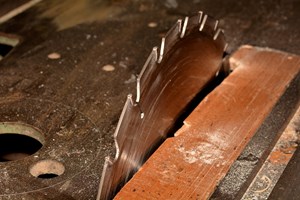
Steam Treating Everyday Objects
Posted on July 29, 2019 in Blog

Many objects we use daily are known to be steam treated to improve their overall durability, such as powdered metal objects, hand tools, drill bits, and saw bits. The typical steam treating process involves placing parts in a steam treat unit, then heating the items to approximately 1000° F. Heat treat furnaces are the best in providing the optimal environment for steam treating. Once the component reaches a predetermined temperature, steam enters the system, where water vapor reacts with the iron in the component to form an oxide layer over the surface.
This oxide layer formed by the water vapor increases the corrosion resistance, hardness, and density in in several materials like stainless steel, copper, and zinc. Steam treating can also seal the porous surfaces of the material and improve an item’s wear characteristics. At times, the oxide layer produced by steam treating does increase certain magnetic properties of metal parts.
After a designated period, workers will remove the component from the heat treat furnace. The highly controlled atmosphere inside the furnace, combined with the reaction of water vapor inside the chamber, forms the classic blue/black finish of the oxide layer as it cools.
Also known as blackening or gun bluing, the black oxide treatment process uses a chemical treatment to convert the top layer of a ferrous metal. Treating everyday objects with a black oxide coating creates a clean black appearance. The process also adds a mild layer of resistance to corrosion and abrasion. Waxing or oiling adds an extra layer of protective corrosion resistance.
Advantages of Steam Treating Everyday Objects
Aside from effectively treating a wide variety of materials, steam treating provides a number of advantages over other processes.
Reliability – Steam treating does not change the dimensions of the treated object as hot dip galvanizing does; maintaining dimensions is essential in the manufacturing of fasteners and other common objects.
Cost-effectiveness – Steam treatment is a cost-effective choice. The steam treatment process is a less expensive alternative to electroplating and other methods of creating corrosion-resistant finishes. Heat treating furnaces can treat large quantities of items, which makes the process faster and less expensive for smaller-sized objects. Typically performed at room temperature settings, the process also keeps production costs lower.
Creates an aesthetically-pleasing, paintable surface – The treatment produces a decorative finish on products, which is especially appealing when a matte finish is preferred over a bright, shiny one. Paint adheres well to the black coating, making finished pieces ultimately customizable. The finish tends to be more ductile, so products can withstand significant deformation before the surface chips. Increased ductility and resistance to chipping make products more durable over time.
Adds resistance for longer lasting components – In addition to adding a layer of mild corrosion and abrasion resistance, using oil during the steam treating process reduces the risk of galling caused by adhesion between two sliding surfaces. Stainless steel fasteners are particularly susceptible to thread galling; steam treating these everyday objects keeps bolt threads intact during their installation.
With all the benefits listed above, steam treating metal components is ideal to ensure the durability and corrosion resistance of multiple everyday objects. Not only does the process produce an aesthetically appealing blue/black coating, everyday objects are known to hold up over longer periods of time as well. For more information about the benefits of steam treating for the objects we use every day, contact Lindberg/MPH at 269.849.2700 or visit our website at www.lindbergmph.com.

